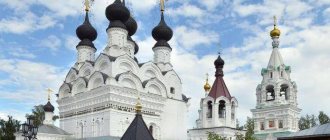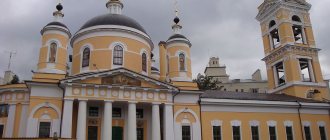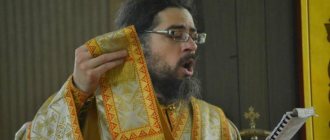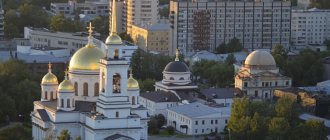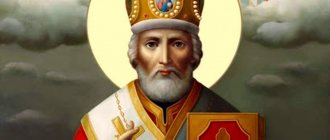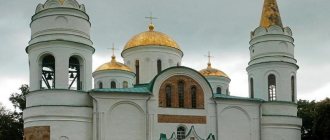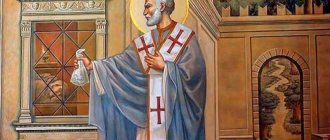Types of Orthodox churches
There were several types of church architecture in Rus'. The temple in the shape of a cross was built as a symbol of the fact that the Cross of Christ is the foundation of the church. It was thanks to him that people were freed from the power of devilish forces.
If the architecture of cathedrals and churches is presented in a circular form, this symbolizes the infinity of the existence of the Church.
When the temple is built in the form of an eight-pointed star, it represents the Star of Bethlehem, which led the Magi to where Jesus was born. The architecture of churches of this type is a symbol of the fact that human history is counted in seven long periods, and the eighth is eternity, the Kingdom of Heaven. This idea originated in Byzantium.
Often the architecture of Russian churches included buildings in the shape of ships. This is the most ancient variation of the temple. Such a building contains the idea that the temple saves believers, like a ship, from the waves of life.
In addition, the architecture of the Orthodox Church is often a mixture of these types. Religious buildings combine circular, cross and rectangular elements.
Byzantine traditions
In the East in the 5th-8th centuries, the Byzantine style in the architecture of temples and churches was popular. Byzantine traditions also extended to worship. It was here that the foundations of the Orthodox faith were born.
Religious buildings here were different, but in Orthodoxy each temple reflected a certain creed. In any church architecture, certain conditions were observed. For example, each temple remained two- or three-part. For the most part, the Byzantine style of church architecture was manifested in the rectangular shape of the buildings, figured roofing, vaulted ceilings with arches and pillars. It was reminiscent of the interior of a church in the catacombs. This style also passed into Russian church architecture, imbued with additional characteristic features.
In the middle of the dome was the Light of Jesus. Of course, the similarity of such buildings to catacombs is only general.
Sometimes churches - architectural monuments - have several domes at once. Orthodox places of worship always have crosses on their domes. By the time Orthodoxy was adopted in Rus', the cross-domed church became popular in Byzantium. He combined all the achievements in Orthodox architecture available at that time.
Typical architecture of Khrushchev and Brezhnev times
Typical architecture from the times of Khrushchev. Photo: kp.ru
Typical architecture from the time of Brezhnev. Business, St. Petersburg. Photo: mhi-russia.ru
Along with the era of Stalin, the era of “architectural excesses” and monumentalism also ended. The same inexpressive buildings based on standard designs can be found both in residential buildings of that time and in public architecture - such as cinemas, schools, hospitals. In a residential area of any Russian city, the so-called Khrushchev buildings will most likely be the basis of the local landscape.
Author: Lidia Utyomova
Cross-domed churches in Rus'
This type of church also developed in Byzantium. Subsequently, it began to dominate - this happened in the 9th century, and then was adopted by the rest of the Orthodox states. Some of the most famous Russian churches - architectural monuments - were built in this style. These include the St. Sophia Cathedral in Kyiv, St. Sophia of Novgorod, and the Assumption Cathedral in Vladimir. They all copy the St. Sophia Cathedral in Constantinople.
For the most part, Russian architectural history is based on churches. And cross-domed structures play a leading role here. Not all variations of this style were widespread in Rus'. However, many examples of ancient buildings are of the cross-dome type.
A design of this kind transformed the very consciousness of ancient Russian people, drawing their attention to an in-depth contemplation of the universe.
Although many architectural features of Byzantine churches were preserved, churches built in Rus' from ancient times had many distinctive unique features.
White stone rectangular churches in Rus'
This type is closest to the Byzantine variations. The basis of such buildings is a square, which is complemented by an altar with semicircular apses and domes on a figured roof. The spheres here are replaced by helmet-shaped coverings of domes.
In the middle of small buildings of this type there are four pillars. They serve as support for the roof. This is the personification of the evangelists, the four cardinal directions. In the center of such a building there are 12 or more pillars. They form the signs of the Cross and divide the temple into symbolic parts.
Wooden temples in Rus'
In the 15th-17th centuries, a completely unique style of constructing religious buildings appeared in Russia, which was radically different from their Byzantine counterparts.
Rectangular buildings with semicircular apses appeared. Sometimes they were white stone, and sometimes they were brick. There were walkways around the walls. The roof was figured, with domes in the shape of poppies or bulbs placed on it.
The walls were decorated with elegant decoration, windows with stone carvings and tiled trims. A bell tower was placed near the temple or above its porch.
A lot of unique features of Russian architecture appeared in the wooden architecture of Rus'. In many ways, they appeared due to the characteristics of the tree. It is quite difficult to form a smooth dome shape from boards. For this reason, in wooden churches it was replaced by a pointed tent. In addition, the entire building took on the appearance of a tent. This is how unique buildings appeared, which had no analogues in the world - churches made of wood in the shape of large pointed wooden cones. There are famous churches in the Kizhi churchyard, which are the brightest representatives of this style.
Stone tented churches in Rus'
Soon the features of wooden churches influenced stone architecture. Stone tented temples appeared. The highest achievement in this style is the Intercession Cathedral in Moscow. It is known as St. Basil's Cathedral. This intricate structure dates back to the 16th century.
This is a cruciform structure. The cross is formed by four main churches, which are located around the central one - the fifth. The last one is square, while the others are octagonal.
The tent style was popular for a very short period of time. In the 17th century, the authorities prohibited the construction of such buildings. They were bothered by the fact that they were very different from ordinary ship temples. Tent architecture is unique; it has no analogues in any culture in the world.
Vanguard
House of Culture named after Rusakov, Moscow. Photo: Bala-Kate / photobank “Lori”
Department store Mostorg on Krasnaya Presnya. Photo: Dmitry Danilkin / photobank “Lori”
In the 1920s, an architectural style that was as revolutionary as the new government appeared in the Soviet state. Simple structures and lack of decoration, glass and concrete - this is how avant-garde buildings were built. For avant-garde architects, the functionality of the building was important, not its aesthetic value. It is not surprising that, in addition to its supporters, the style also had ardent opponents, who called avant-garde buildings “concrete tumors” on the body of Moscow. For example, contemporaries appreciated the Melnikov House of Culture named after Rusakov. The Mostorg department store on Krasnaya Presnya, another well-known example of the avant-garde, was greeted more calmly.
New stylistic forms
Russian churches were distinguished by their diversity in decoration, architecture, and decorations. Colorful glazed tiles have become especially popular. In the 17th century, Baroque elements began to dominate. Naryshkin Baroque put symmetry and completeness of multi-tiered compositions at the heart of everything.
The creations of the capital's architects of the 17th century - O. Startsev, P. Potapov, Y. Bukhvostov and a number of others - stand out. They were some harbingers of the era of Peter's reforms.
The reforms of this emperor affected, among other things, the architectural traditions of the country. The architecture of the 17th century in Russia was determined by the fashion of Western Europe. There were attempts to achieve a balance between Byzantine traditions and new stylistic forms. This was reflected in the architecture of the Trinity-Sergius Lavra, which combined ancient traditions and new trends.
During the construction of the Smolny Monastery in St. Petersburg, Rastrelli decided to reflect Orthodox traditions in the construction of monasteries. However, the organic combination did not work out. The 19th century saw a revival of interest in the architecture of the Byzantine era. It was only in the 20th century that attempts were made to return to medieval Russian architectural traditions.
Rococo
Chinese Palace, St. Petersburg. Photo: Litvyak Igor / photobank “Lori”
Roller coaster, St. Petersburg. Photo: Litvyak Igor / photobank “Lori”
In general, the Rococo style, popular in the second half of the 18th century, has much in common with Baroque. The main differences lie in the details. Buildings in the Rococo style are richly decorated with sculptural decorations - vases and flower garlands, masks or simply cute curls. Few similar buildings have survived in Russia. These include the Chinese Palace and the Rolling Hill pavilion in Oranienbaum.
Russian Rococo
Church of the Intercession on the Nerl
The architecture of the Church of the Intercession on the Nerl is famous throughout the world. It is distinguished by lightness and lightness; it is a true masterpiece of the Vladimir-Suzdal architectural school. The grace manifested in the architecture of the Church of the Intercession on the Nerl became possible thanks to the ideal combination of the building with the environment - Russian nature. It is noteworthy that the temple is included in the UNESCO list of world monuments.
The building reflects the path upward, to God, and the road to it is a kind of pilgrimage. Information about the church is preserved in the Life of Andrei Bogolyubsky. It was erected in 1165, it was a memorial for the prince's son Izyaslav. He died in the war with Volga Bulgaria. According to legend, the white stones were transported here from the defeated Bulgarian principality.
It is noteworthy that descriptions of the architecture of the Church of the Intercession on the Nerl contain many comparisons of this building with a white swan floating on the water. This is the bride standing at the altar.
All that remains of the building dating back to the 12th century is a square - a skeleton with a dome. Everything else turned out to be destroyed over time. The restoration took place in the 19th century.
The descriptions of the architectural monument of the Church of the Intercession on the Nerl contain information about the verticality of the walls. But due to the measured proportions, they look inclined; due to this optical effect, the building looks taller than it actually is.
The church has a simple, no-frills interior. The frescoes were knocked off the walls during the restoration in 1877. However, there is an iconostasis with icons.
There are many wall reliefs left on the outer surface. Biblical figures, birds, animals fly by here, and there are also masks. The central figure is King David, who reads the psalms. At his side is a lion, the personification of his power. There is a dove nearby - a sign of spirituality.
Church of the Ascension in Kolomenskoye
The first stone tent-type temple in Rus' is the Church of the Ascension in Kolomenskoye. Its architecture reflects the influence of the Renaissance. It was erected by Vasily III in honor of the birth of his heir, Tsar Ivan IV the Terrible.
The architectural features of the Church of the Ascension are manifested in the cruciform shape of the building, which turns into an octagon. A large tent rests on it, in turn. It overshadows the interior space of the church. It is noteworthy that there are no pillars. The temple, distinguished by its expressive silhouette, is surrounded by a gallery with staircase descents. They are executed quite solemnly.
The church has a lot of additional details that migrated here from the Renaissance. At the same time, there are many features from the Gothic. Italian bricks, the connection of the building with the centric shape of the temples of Italy give a hint that this project was created by an Italian architect who worked at the court of Vasily III. Accurate information about the author has not survived to this day, but, according to assumptions, it was Petrok Maloy. It was he who was the author of the Church of the Ascension in the Moscow Kremlin, the walls and towers of Kitay-Gorod.
Vladimir-Suzdal churches
Architecture flourished here during the times of Andrei Bogolyubsky and Vsevolod III. Then a church with a palace was erected here. They glorified the capital of the principality. Here stone was skillfully processed and techniques from wooden architecture were used.
In the 12th century, first-class structures made of high-quality white stone - limestone - rose here. The most ancient of them had simple decorations. The windows in the temples were narrow, they more likely resembled slits of loopholes rather than windows. The decoration of churches with stone carvings began in the 12th century. Sometimes it reflected folklore subjects, sometimes the Scythian “animal style”. The presence of Romanesque influences is also noted.
Smolensk-Polotsk churches
When Smolensk architecture was just developing, there were no architects here yet. Most likely, the first buildings here were erected thanks to the participation of Kiev or Chernigov residents. In Smolensk churches there are many marks on the ends of the bricks. This indicates that, most likely, Chernigov residents left their mark here.
The architecture of these cities is distinguished by its scope, which speaks in favor of the fact that in the 12th century they already had their own architects.
Smolensk architecture was popular in Rus'. Architects from here were called to many other ancient Russian lands. They also built buildings in Novgorod, which was the largest center in the country. But this rise was short-lived - it lasted 40 years. The thing is that in 1230 an epidemic broke out, after which the political situation in the city changed greatly. This was the end of the work of local architects.
Stalinist neoclassicism
Central Academic Theater of the Russian Army, Moscow. Photo: Aleshina Oksana / photobank “Lori”
The main building of Moscow State University on Vorobyovy Gory, Moscow. Photo: Denis Larkin / photobank “Lori”
During Stalin's time, architects began to turn again to the classical heritage, although in a slightly different sense. The buildings of the 1930s and 40s were majestic and pompous - with columns and stucco, wall paintings and an abundance of decor with Soviet symbols. Columns have come back into fashion. One of the interesting interpretations of the classicism style in Stalin’s time was the Central Academic Theater of the Russian Army in the shape of a five-pointed star and the Main building of Moscow State University on Sparrow Hills.
Godunov style
Conventionally, temples in the style of Godunov classicism also stand out. These were churches built during the period when Boris Godunov (1598-1605) sat on the throne of Rus'. Then construction techniques were canonized, reflected in the symmetry and compactness of buildings.
In addition, Italian order elements have become popular. The Russian style turned out to be canonized in the Italian manner.
The variety of structures has decreased. But stylistic unity came to the fore. This manifested itself not only in Moscow, but throughout Rus'.
Classicism
Tauride Palace, St. Petersburg. Photo: Ekaterina Ovsyannikova / photobank “Lori”
Bolshoi Theatre, Moscow. Photo: Gennady Solovyov / photobank “Lori”
Buildings in the classicist style can be found in many Russian cities. This architectural trend was widespread at the end of the 18th - first half of the 19th century. Palaces and estates, theaters and even warehouses were built in the classical style. The key detail by which you can easily identify a monument from the Classical era is the column. More precisely, many columns. Also, buildings in this style are distinguished by restraint, symmetry and laconic decor. Such are, for example, the Tauride Palace in St. Petersburg and the Bolshoi Theater in Moscow.
Russian classicism
Patterned
The style called patterned is also noteworthy. It appeared only in the 17th century in Moscow. It is characterized by intricate shapes, decor, and complex compositions. Silhouettes in this style are incredibly picturesque. Patterning is associated with pagan roots and the late Renaissance in Italy.
For the most part, buildings in this style are represented by churches with closed vaults, without pillars and with high refectories. They have a tent covering. The interior is unusually rich in colored ornaments. There is a lot of decor inside.
Church architecture and art: from Peter I to Nicholas II
Part 1. The end of the 17th - first half of the 18th century
Saint Isaac's Cathedral
Classicism was a new direction in art, established at the state level. In church architecture, on the one hand, he demanded strict adherence to the language of forms and spatial-compositional solutions, on the other hand, he did not exclude a certain freedom of creative pursuits, which was widely used by Russian masters. This, ultimately, despite all the opposition of classicism to Russian traditions, led to the creation of majestic and uniquely beautiful monuments that enriched both Russian and world culture.
The formation of classicism in Russia began under Catherine II.
Being a pragmatic person, the empress in the first years of her reign demonstrated particular piety and reverence for church traditions. She, just like Elizaveta Petrovna, went on foot to the Holy Trinity Lavra, went to Kyiv to venerate the saints of Pechersk, fasted and received communion with all her court staff[1]. All this played a significant role in strengthening the personal authority of the empress, and “thanks to the constant tension of thought, she became an exceptional person in the Russian society of her time”[2].
Catherine II sought, following Peter I, to reshape Russian traditions according to European patterns
The architecture and art of this time were influenced by many different factors that lay essentially outside their boundaries, but led to dramatic changes - the replacement of the “Elizabethan Baroque” with classicism. First of all, it is necessary to point out Catherine’s deep hostility towards her predecessor on the throne: everything that was sweet and dear to one was not accepted and condemned by the other. The decisive reason that influenced the replacement of the general imperial baroque style with classicism was the desire of Catherine II to reshape, following in the footsteps of Peter I, Russian cultural and social traditions according to European models and patterns.
The temples founded in both capitals under Elizaveta Petrovna were completed in the Baroque style, but with the introduction into their appearance of obvious elements of the new state direction in art[3]. The Russian imperial court accepted classicism as a system of international artistic culture, within the framework of which from now on domestic culture was to exist and develop. Thus, half a century later, the initiatives and ideas of Peter I in the field of architecture and art find their real embodiment.
Catherine II
However, it should be noted that our Fatherland also originally had European cultural roots: “The ancient tradition came to Rus' through Byzantium, which had already carried out its creative implementation in the Christian spirit - rethinking”[4]. Our culture has always been part of the world, primarily European, Christian culture. A special part, but not closed, not isolated. The entire history of Russian architecture clearly demonstrates that there has never been “cultural loneliness”[5]. Each era presented contemporaries with new architectural buildings, erected using not only technical innovations[6], but also stylistic and visual elements borrowed from outside. This can be proven by Moscow monuments of the late 15th – early 16th centuries, examples of Moscow Baroque, and St. Petersburg buildings from the time of Peter I[7].
Speaking about Russian architecture, we should not forget about this. A phenomenon that has been repeatedly studied - the “traditions of Russian temple construction” - has, at the same time, such a little-studied basis: Russian architecture (and church architecture is no exception) for several centuries after the adoption of Christianity was represented by wooden architecture. This was natural due to the natural and geographical position of the country. But the tree is not only susceptible to rotting, but also unstable in the face of the elements, primarily fires that raged, sweeping away literally everything. Therefore, we should not forget that wooden architecture was developed not only on the Russian periphery. Thus, at the beginning of the 14th century, under Ivan Kalita, the Moscow Kremlin was made of wood. And even with the increasingly frequent transition (since the 10th–11th centuries) to stone in temple construction, wooden church architecture continued to exist - and not only preserved the existing construction and engineering traditions, but also created new ones, including church ones. Let us remember that in Kizhi there is a 22-domed 37-meter church, built in 1714, that is, at the height of Peter the Great’s reforms. And this is a true masterpiece of Russian national temple architecture.
It seems to us that the remark of D.S., often mentioned in the literature. Likhacheva: “Ancient Rus' is “our antiquity”” [8] - not only bright, but also deep, and it speaks of two phenomena. One, more visible (obvious) thing is the special way in which Russian culture inherited antiquity, as has already been mentioned. The second is a reminder of the deep layers of Russian culture that were once concentrated in wooden architecture. But the course of cultural development led to the fact that the movement along such an “ancient” path was interrupted[9].
For the European self-awareness of that time, the very concept of “tradition” became something archaic
During the reign of Catherine II, for the first time (even if we do not forget about Peter’s innovations), church architecture was completely under the influence of consistent state pressure aimed at reorienting to Western secular models. For the European self-awareness of that time, the very concept of “tradition” became something archaic[10]. It was the desire to consign to oblivion the philosophy of continuity of Russian tradition in architecture and art that became the main feature of the time when European classicism came to Russia.
In Europe, the return to the culture of Ancient Greece and Rome in the 18th century became a fundamentally new large-scale phenomenon that soon covered all Western countries[11]. But if for them classicism (“neoclassicism”) was nothing more than a return to their own roots in creative quests, then for Russia it became an innovation, especially in church architecture. However, we note that the foundation of the tradition has still been preserved. So, what remains is the three-part construction of the temple, inherited from Byzantium.
Latently, unconsciously, new architectural elements were intertwined with original national ones. Let us pay attention: Russian wooden temple architecture in its construction striving for vertical forms[12]. This was due to the use of the main building material - wood, logs. And such a basic architectural module as a column, so beloved by classicism, provided a visual (albeit somewhat conditional) parallel with the external elements of national wooden architecture.
Nevertheless, classicism significantly changed many things - not only in the appearance of churches, but also in the entire architectural environment.
Traditional Russian cities occupied vast areas due to extremely sparse buildings[13], which harmoniously included a natural landscape with gardens, vegetable gardens and even forests[14]. All this gave the city, with its ornate interweaving of streets, alleys and dead ends, a unique flavor[15]. At the same time, it was the temples that always acted as town-planning dominants, by which the main part of the city could be distinguished.
General redevelopment[16] of Russian cities[17], carried out in accordance with European urban planning guidelines[18], rationalized space[19]; at the same time, the existing stone temples gradually disappeared among new buildings, as a result of which they lost their dominant sound in the urban environment. As a result, the main guidelines of the socio-cultural space in which a person’s life attitudes were formed have shifted. Temples and church buildings remained, as before, as dominant architectural structures only in rural areas.
Temple construction in Moscow during the reign of Catherine II was insignificant: mainly repair work was carried out on dilapidated buildings. In St. Petersburg, construction was still underway.
Cathedral of the Life-Giving Trinity in the Holy Trinity Alexander Nevsky Lavra
Soon after the coronation, Empress Catherine II began choosing a design for the new main cathedral of the Alexander Nevsky Monastery - by that time the temple had been dismantled due to dilapidation[20]. In the Trinity Cathedral (1776–1790) of the Alexander Nevsky Lavra, the philosophical ideas of European classical buildings were embodied as fully as possible. In addition, after the consecration of the cathedral, paintings by European artists on biblical themes were placed inside it, which gave the entire interior decoration a solemn and strict, but at the same time palace look.
One of the few churches founded under Catherine II in St. Petersburg was St. Isaac's Cathedral (the third in a row). But of the elements of the new style in this cathedral, perhaps, there was only one thing - decorating the walls with marble. Such architectural ideas could not fully satisfy Catherine’s tastes, so construction moved extremely slowly: by the time Paul I ascended the throne, the temple had only been completed to the vaults.
The emergence of new church architecture in the classical style was accompanied by almost universal reconstruction - in favor of the ideas of classicism - of already existing churches. This is the first time in the history of Russian church building that something like this has happened on such a large scale. First of all, the alterations everywhere affected the roof coverings of churches, which were replaced with a simple hipped roof, which, naturally, radically changed the entire architectural sound of the buildings. Old windows were cut out and new ones were cut, the architectural decoration of the platbands was removed, additional porticoes with columns were added, the facades were decorated with monumental paintings done in oil painting on canvas. There are dozens of similar examples; Among the historically significant monuments that underwent restructuring, we will name the Assumption Cathedral of Vladimir, as well as the Trinity Cathedral, the Church of the Descent of the Holy Spirit and the Church of St. Nikon of Radonezh in the Trinity-Sergius Lavra[21]. As historian E.E. points out. Golubinsky, during the time of Catherine II, all the fortress towers of the monastery were also rebuilt in a Western style, which changed the entire appearance of the ancient monastery almost beyond recognition. Such innovations did not enrich its overall appearance; it was a striking example of the inorganic addition of structures of one time to significant architectural elements of another.
Assumption Cathedral of Vladimir
Artificial “grafting” of the ideas of classicism affected, in one way or another, almost all ancient Russian monuments. The wholesale reconstruction of churches became a demonstration of the indiscriminate and inappropriate absorption of national architectural ideas and images into the European tradition: what was original almost dissolved into oblivion, however, the new did not look at all organic or even aesthetically pleasing on ancient buildings.
The interior space of a traditional Russian church with its twilight and frescoes created conditions for prayerful repentance and sacred standing before God. And chipping away old windows and cutting through new windows created a different, rarefied air space in the interiors of ancient temples. In such a space, the fresco paintings, which consisted of large spots of color and reproduced symbols[22], the reading of which did not require examination and admiration, but called for prayerful deepening and spiritual peace, ceased to be properly perceived[23]. The ancient practice of fresco painting itself became inappropriate with a new interpretation of sacred space. Previously, frescoes filled the entire temple, consistently telling about gospel events or events in the life of the Church. The ideas of the classicist decoration of the temple implied a fundamentally different initial task. The general space of the internal walls was freed from images as much as possible. Stories on various biblical themes were presented in the form of compositions not connected into a single narrative; they were “hung as separate canvases on the walls,” and each image was mounted in a decorative pictorial frame[24].
The interiors of churches were “corrected” to suit classicism, and the relationship between paintings, natural light and liturgical rites was disrupted
In fact, the complex relationship between fresco paintings, natural light and liturgical rites was disrupted. The interiors of the temples, “corrected” to the ideas of classicism and decorated with paintings done in oil technique and sometimes, unfortunately, not of the highest artistic level[25], began to loosely resemble the hall spaces of European buildings. Today, most of the temple interiors have been restored to their original fresco paintings, which were preserved under later records[26]. Of the few that have survived to this day from that time, the paintings of the Great Cathedral of the Donskoy Monastery, completed in 1775, seem to most fully and harmoniously take into account the uniqueness of the sacred space[27]. And this is actually an isolated example.
The new churches, built in the classicist style, were characterized by clarity of composition, conciseness of volumes, perfect harmony of proportions within the classical canon, fine drawing of details, rationality and ergonomics[28]. But churches in the Byzantine traditions, which became national after centuries, largely have all the characteristic features listed above.
After the death of Empress Catherine II, her only son Pavel Petrovich ascended the throne in 1796[29]. The new emperor's policy towards the Church can be described as lenient[30]. During the Pavlovian period, there was virtually no temple construction in the capital. It is worth paying attention to this fact. By the time Paul ascended the throne, the third cathedral in the name of St. Isaac of Dalmatia had already been under construction for 28 years. Paul ordered the marble prepared for its decoration to be taken out and used in the construction of the Mikhailovsky Castle[31]. However, it was apparently indecent to completely consign the construction of the cathedral, founded by Peter I, to oblivion, and Paul ordered it to be completed as soon as possible with a minimum of funds[32], which required a change in the original plans, which is why the construction of the cathedral was again delayed, and it was consecrated only in 1802.
Cathedral in honor of the Kazan Icon of the Mother of God
The only large-scale temple-building undertaking of the reign of Paul I was the cathedral in honor of the Kazan Icon of the Mother of God in St. Petersburg: in 1800, the project of the young talented architect A.N. Voronikhin[33].
A rather unusual innovation within the framework of classicism was the church in the name of the Life-Giving Trinity (1785–1790) near St. Petersburg [34], or more precisely, its bell tower in the form of a tetrahedral pyramid, which is why the people began to call this temple “Kulich and Easter” [35]. Also unique in its artistic design is the temple-monument in honor of the Image of the Savior Not Made by Hands (1813–1823, Kazan), built already under Alexander I. This church, erected in memory of the soldiers who fell during the capture of Kazan in 1552, has the shape of a truncated pyramid, where each side is decorated with a portico[36]. However, the “non-singularity” of the given examples is evidenced by interesting architectural solutions of a later time, for example, the pyramidal St. Nicholas Church in Sevastopol (1857–1870). Thus, the essentially foreign ideas of ancient Egyptian architecture, actually alien to Russian culture, gradually acquired a new artistic meaning.
After the coup d'etat on March 12, 1801, the Russian throne was occupied by the son of Paul I, Alexander[37]. In relation to the Church, the emperor pursued basically the same policy as Catherine II. But he carried out construction on a much larger scale, including church construction, and not only in St. Petersburg, embodying new architectural ideas and projects. The ideas of classicism flourished like never before.
On August 27, 1801, Alexander I was present at the foundation stone of the Kazan Cathedral in St. Petersburg, and ten years later [38] he already prayed during the consecration of this truly unique structure, which became one of the most beautiful buildings not only in Russia, but also in Europe.
Vasily Petrovich Stasov
Of course, Russian classicism in all its manifestations was oriented toward European culture, but a political factor intervened in artistic life and weakened classicism in Russia—the Patriotic War of 1812–1814. After the Napoleonic invasion, the destruction of cities, the mockery of churches and shrines, and above all the Moscow Kremlin[39], the very image of European civilization faded and was no longer perceived by many of our ancestors with the same reverence. Political guidelines have changed - and the architecture and art of the High Empire era received a new vector of development associated with the glorification of the heroism of the Russian army, the patriotic valor of the people and the autocracy.
The series of St. Petersburg buildings of the late classicism period is completed by the construction of two churches designed by V.P. Stasov- Preobrazhensky (1825–1829)[40] and Troitsky (1828–1835)[41]. Both of these church buildings were founded under new socio-political conditions and significantly changed tastes. In these churches, the author seemed to be trying to give a new interpretation to the forms and philosophical ideas of classicism through a return to the traditional Russian five-domed structure.
Stasov tried to combine classicism with tradition: porticos and columns with Russian five-domed architecture
According to the established opinion, the construction of St. Isaac's Cathedral according to the design of A. Montferrand (1817–1858; already the fourth in a row) actually ends the era of classicism in Russia[42]. The author was faced with the same problem that V.P. tried to solve. Stasov: to embody the traditional Russian five-domed structure in a building that is classical in spirit. For St. Isaac's Cathedral, majestic multi-figure bronze reliefs, sculptures, unique entrance doors, and columns were made. All these works are creations of the best masters. St. Isaac's Cathedral is an expression of the official understanding of Orthodoxy at that time[43].
As for the Mother See, in the first quarter of the 19th century, church building in Moscow was insignificant, which is understandable: according to the state commission, in Moscow in 1812, 6,496 houses out of 9,151 and 122 churches out of 329 were destroyed [44]. Large-scale construction and restoration work began immediately after liberation from Napoleonic troops[45].
Project of the Cathedral of Christ the Savior on Sparrow Hills, architect A. Vitberg
A special place in Moscow architecture was to be occupied by the impressive building of the Cathedral of Christ the Savior on Sparrow Hills, erected in honor of the victory over the French[46]. In its architectural design it was a traditional building in the classicist style. However, in 1826, the construction of the temple, which began in 1817, was stopped by decree of Emperor Nicholas I: for nine years, not even the foundation was built, although a lot of money was spent. They never returned to the idea of building on Vorobyovy Gory.
It is important to emphasize that following classical models in the church architecture of the ancient Russian capital had certain specifics: “Moscow architecture of mature classicism was characterized, in comparison with St. Petersburg, by greater softness and warmth in the interpretation of classical forms”[47].
In general, the Alexander era in culture is characterized by serious internal contradictions. During this period, there was a kind of collision of two directions - the ongoing classicism and the emerging Russian Renaissance. The heterogeneity of ideas, styles, and searches, in our opinion, is one of the characteristic features of the architecture and fine arts of Russia at this time.
As we see, classicism in Russia went through all stages of its development: from a restrained early “invasion” into traditional temple buildings, when it was intertwined with “Elizabethan Baroque,” to establishing itself with an almost declarative rejection of any non-classical images, after which its gradual decline began , which manifested itself primarily in the church architecture of the province, where it turned into increasingly mediocre and uniform forms[48]. Classicism, transformed at a later time into the Empire style, was aimed at glorifying the state power of the victorious country.
Despite all the contradictions in the process of adapting the ideas of classicism to, so to speak, “Russian conditions,” there were—and this must be emphasized—some positive aspects. Russian masters, having mastered the ideological, artistic, technical and engineering fundamentals and techniques of classical architecture in the shortest possible time, created examples equal to their European counterparts, which significantly advanced Russian art, including church art, forward. And such magnificent churches as Kazan and St. Isaac’s have become truly world masterpieces. And it is quite appropriate to talk about the era of classicism in Russia as “Russian classicism” - a unique and inimitable phenomenon of world culture as a whole.
(The ending follows.)
Totem style
Baroque, which manifested itself most clearly in St. Petersburg, was also reflected in the buildings of the Russian north. In particular, in the city near Vologda - Totma. The uniqueness of the architecture of his buildings led to the emergence of the “Totem Baroque”. This style appeared in the 18th century; already in the next century there were at least 30 temples built in this style. But in the same century, many of them were rebuilt. At the moment, they are mostly destroyed or remain in disrepair. The features of this style were adopted during the sea voyages of local merchants. They were the customers of these churches.
Baroque
Winter Palace, St. Petersburg. Photo: Vitas / photobank “Lori”
Church of the Sign, Dubrovitsy. Photo: gooper.ru
This architectural style came to Russia at the very end of the 17th century. The first buildings appeared in Moscow, then St. Petersburg was actively built up with baroque buildings. The Baroque style is easy to define: its main features are complex shapes and an abundance of decorations. Actually, the term “Baroque” itself translated from Italian means “bizarre, strange.” Examples include the Winter Palace in St. Petersburg and the Church of the Sign in Dubrovitsy in the Moscow region.
Ustyug style
Some of the earliest religious buildings in Veliky Ustyug were buildings dating back to the 17th century. It was at that moment that the foundations of stone architecture began to appear here. The architectural style of this area flourished in the 17th century. Construction continued on its features for just over 100 years. During this time, many local architects appeared in Veliky Ustyug, who were distinguished by their great talent and unprecedented skill. They left behind many unique churches. At first, five-domed churches with side chapels were common. And in the 18th century, temples with a longitudinal axis gained popularity.
Modern
House, St. Petersburg. Photo: spb-guide.ru
Hotel "Metropol", Moscow. Photo: liveinmsk.ru
Buildings in the Art Nouveau architectural style appeared at the end of the 19th and beginning of the 20th centuries. The abundance of glass and iron, the use of mosaics and paintings on the facades, unusual curved lines and asymmetry are all signs of Art Nouveau. A house in St. Petersburg or the Metropol Hotel in Moscow are the most characteristic buildings in this style.

